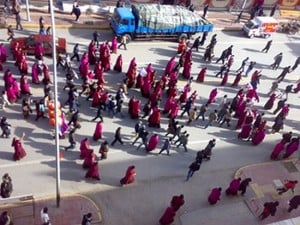
Protests near Labrang Monastery on March 14, 2008. (TCHRD)
According to several sources, all of the monks have now been detained and there are fears for their welfare in custody.
This was the second protest at Labrang in recent weeks following major unrest that broke out at the monastery with monks and laypeople calling for independence while marching with the Tibetan flag on March 16. All of the Labrang monks who were detained following this protest, which was broken up by armed police, were severely beaten, according to reliable reports. One of the monks who demonstrated on March 16 and who has now been released from custody was apparently tortured so severely that his psychological condition is severely affected.
The recent demonstration at Labrang is the second to interrupt a state-organized media tour since the wave of protests began across the Tibetan plateau on March 10, the anniversary of the 1959 uprising against Chinese rule. Monks from the Jokhang Temple in Lhasa protested in front of a group of foreign journalists on March 28 after authorities allowed foreign journalists into Lhasa for the first time since the effective closure of the city to outsiders. The monks, some of whom were crying, told journalists: “The government is always telling lies, it’s all lies” and “We want freedom and we want peace”.
According to eyewitnesses, today’s demonstration at Labrang lasted for approximately ten minutes and officials did not interfere, although the press “minders” from Beijing seemed uncomfortable. At a press conference after today’s demonstration at Labrang, journalists asked about the monks who protested. A member of the Democratic Management Committee (the administrative apparatus of the state in religious institutions in Tibet) of the monastery told them that if they had broken national security laws, they would be dealt with “according to the law”, and if they were found to have broken rules of the monastery, the monastery would deal with the case.
Press trip scheduled to visit Machu tomorrow
The journalists who visited Labrang are scheduled to visit Machu (Chinese: Maqu) in Kanlho Tibetan Autonomous Prefecture, Gansu (the Tibetan area of Amdo) tomorrow (April 11). There have been mass detentions and a severe crackdown in the Machu area following protests on March 16 by local people, nomads and students, who carried images of the Dalai Lama or Tibetan flags, shouted pro-independence slogans, and called for the return of the Dalai Lama. Some demonstrators targeted government and other property during the protest, hurling stones at government offices and Chinese businesses, seen as symbols of Chinese rule. Several vehicles belonging to the government were set on fire, and the local police station was set alight. The demonstration was suppressed after convoys of armed police arrived in the town, and mass detentions began soon afterwards.
Journalists in the official tour, both foreign and Chinese, are likely to be taken to the areas in Machu town where property was damaged by protestors. Media trips to Tibetan areas are highly controlled by the authorities and few signs of the crackdown may be visible. According to reports from Lhasa, during the visit of the group of foreign journalists on March 28, followed by the visit of international diplomats, security was less stringent during the visit and tightened again after their departure. One reliable source said: “When the foreign media and diplomatic mission arrived, the military was ‘hidden’ in compounds out of sight behind the streets. When the foreigners left, the military came back out on the streets to conduct the check points.”
Further protests took place around March 16 in other areas of Machu county, including Ngora township, Malma, Wayan and Murshak, linked to the demonstrations in Machu town following communication by cellphone. Monks and local people shouted slogans including ‘Long live the Dalai Lama’ and for Tibetan independence outside the government offices in Ngora. In Ngora township alone, around 95 people including monks were detained following the protest. Thirty of these detainees have now been released after beatings, but others from Ngora have been moved to unknown locations and may face charges for “more serious crimes”, which include in at least one case of the lowering of the Chinese flag and raising of the Tibetan snow lion flag.

